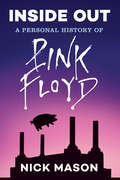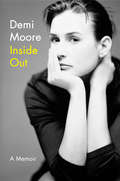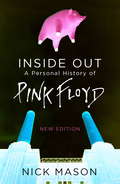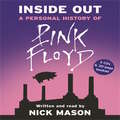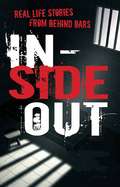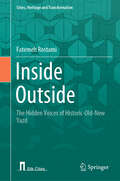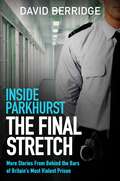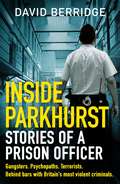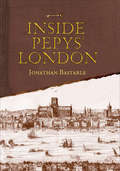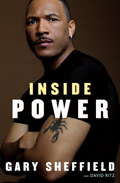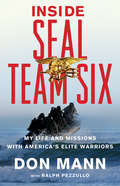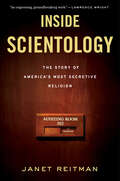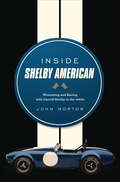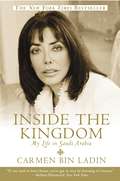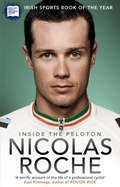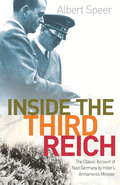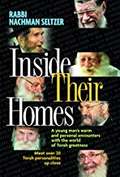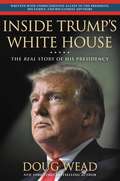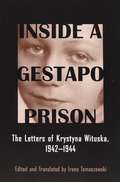- Table View
- List View
Inside Out (Reading Edition): A Personal History of Pink Floyd (Reading Edition)
by Nick MasonThe definitive history of Pink Floyd by founding member Nick Mason, this reading edition brings up-to-date the band's incredible story as told uniquely from the inside out. Including the complete text of the original in an easy-toread format, a new chapter covering the passing of Rick Wright and the release of the group's final album, and 80 pages of images from Mason's archives plus new photos, Inside Out is a masterly rock memoir and an eye opener for both veteran fans and those just discovering the group.
Inside Out: A Memoir
by Demi MooreFamed American actress Demi Moore at last tells her own story in a surprisingly intimate and emotionally charged memoir. <P><P>For decades, Demi Moore has been synonymous with celebrity. From iconic film roles to high-profile relationships, Moore has never been far from the spotlight—or the headlines. <P><P>Even as Demi was becoming the highest paid actress in Hollywood, however, she was always outrunning her past, just one step ahead of the doubts and insecurities that defined her childhood. Throughout her rise to fame and during some of the most pivotal moments of her life, Demi battled addiction, body image issues, and childhood trauma that would follow her for years—all while juggling a skyrocketing career and at times negative public perception. <P><P>As her success grew, Demi found herself questioning if she belonged in Hollywood, if she was a good mother, a good actress—and, always, if she was simply good enough. <P><P>As much as her story is about adversity, it is also about tremendous resilience. In this deeply candid and reflective memoir, Demi pulls back the curtain and opens up about her career and personal life—laying bare her tumultuous relationship with her mother, her marriages, her struggles balancing stardom with raising a family, and her journey toward open heartedness. <P><P>Inside Out is a story of survival, success, and surrender—a wrenchingly honest portrayal of one woman’s at once ordinary and iconic life. <P><P><b>A New York Times Bestseller</b>
Inside Out: A Personal History of Pink Floyd
by Nick MasonUPDATED FOR 2017 WITH A NEW CHAPTERThe definitive history of Pink Floyd, one of the world's great bands, by founder member Nick Mason.Pink Floyd is one of the most creative, successful and enduring bands of all time. As the only member to have been part of the band throughout the 50 years of its existence, and the first to write a personal take on their history, Nick Mason gives unique insights into Pink Floyd's highs and lows: from their emergence in the late 1960s underground, to the huge worldwide success of The Dark Side of the Moon and the rifts and pressures that developed within the group.In a new chapter Nick Mason looks back at the years following the band's final performance at Live 8 in July 2005 and reflects on the huge changes that have occurred since: the irreplaceable losses, the new releases and the impact on the Floyd's continued success of both digital technology and social media. Intelligent, original and self-deprecating, Inside Out is the first-hand story of a band that has become a legend, as celebrated by the Victoria & Albert Museum's landmark Pink Floyd exhibition in 2017.
Inside Out: A Personal History of Pink Floyd
by Nick MasonUPDATED FOR 2017 WITH A NEW CHAPTERThe definitive history of Pink Floyd, one of the world's great bands, by founder member Nick Mason.Pink Floyd is one of the most creative, successful and enduring bands of all time. As the only member to have been part of the band throughout the 50 years of its existence, and the first to write a personal take on their history, Nick Mason gives unique insights into Pink Floyd's highs and lows: from their emergence in the late 1960s underground, to the huge worldwide success of The Dark Side of the Moon and the rifts and pressures that developed within the group.In a new chapter Nick Mason looks back at the years following the band's final performance at Live 8 in July 2005 and reflects on the huge changes that have occurred since: the irreplaceable losses, the new releases and the impact on the Floyd's continued success of both digital technology and social media. Intelligent, original and self-deprecating, Inside Out is the first-hand story of a band that has become a legend, as celebrated by the Victoria & Albert Museum's landmark Pink Floyd exhibition in 2017.
Inside Out: A Personal History of Pink Floyd
by Nick MasonOne of the most fascinating rock bands ever, Pink Floyd was formed in 1965. After a year in the London 'underground' experimenting with revolutionary techniques like lights which matched their music, they released their first single in 1966. Their breakthrough album, THE DARK SIDE OF THE MOON, was released in 1973 and stayed in the charts until 1982, the longest a record has ever been continuously in the charts, becoming one of the best-selling albums of all time. In 1975 they released WISH YOU WERE HERE which reached iconic status, then in 1979 THE WALL went to number 1 in almost every country in the world. The movie version of THE WALL starring Bob Geldof was released in 1982, becoming a cult favorite. In the 1980s a rift developed between the band members which culminated in law suits. Only recently have there been reconciliations which have allowed founder member Nick Mason to write his personal take on the band's history.(p) 2005 Orion Publishing Group
Inside Out: Real Life Stories from Behind Bars (Quick Reads)
by Parc PrisonersBrought together by their crimes, the prisoners, young offenders and young people at Bridgend's Parc Prison share their stories of life on the other side of the security walls. Whether they are hardened criminals, prolific offenders or teenagers in trouble for the first time, they all have one thing in common - they had a life outside. Through their creative writing workshops, these prisoners have put into words their feelings and experiences about doing time at Parc Prison and talk about their hopes for the future. Half of all prisoners have the reading skills of a child of 11 or younger, rendering them virtually unemployable and creating a vicious circle that only encourages a return to crime when they are freed. This book is the result of new initiatives to improve basic skills in prisons and makes compelling reading.
Inside Outside: The Hidden Voices of Historic-Old-New Yazd (Cities, Heritage and Transformation)
by Fatemeh RostamiThis book is the voice of everyday people talking about their city’s poetry–prose transformation. Through the narrative-imagination of the local lives, the book takes the reader on a journey of the past–present–future of Yazd: how the city was formed and transferred from the historic core to the newer parts over time; how people daily engage with the city; why some people enjoy living in the Historic Yazd while others prefer dwelling in the Old and New cities; why these areas are still occupied with the locals keeping the whole city alive and dynamic; if there is a socio-cultural interrelationship between these areas; and hearing the locals’ wishes about the future of their city. Using the "shoe" as a symbol of various social fabrics of Yazd, the book reveals unseen important matters affecting city life from the moment residents put on their shoes to engage within the city and their public lives to the time they remove their shoes on entering their households to share in their private lives. Beyond hearing the locals' voices, the book also examines to what extent scholars’ definitions of place are in parallel or in contrast with the ordinary people’s definitions of their living places. The book aims to introduce a new urban methodology to urban studies so that local voices can truly be considered in urban planning and design projects. This approach is particularly absent in Iranian urban studies on which this book attempts to investigate, which was examined in Yazd.
Inside Parkhurst - The Final Stretch: More stories from behind the bars of Britain’s most violent prison
by David BerridgeReturn to HMP Parkhurst in this raw and fascinating account of life as a prison officer. David Berridge returns with more stories from his time as a prison officer at HMP Parkhurst, giving a uncompromising look at the harsh reality of working in British prisons. From dealing with inmate violence and clearing out defiled prison cells to the unsavoury nature of prison language and life, this is an even more detailed look inside Britain's most infamous prison.Through it all, David retains his wry humour and offers a much-needed assessment of the state of UK prisons today, the job crisis and poor recruitment, the corruption and gangs running rife, and the mental health epidemic hitting prisoners, causing many to take their own lives.
Inside Parkhurst - The Final Stretch: More stories from behind the bars of Britain’s most violent prison
by David BerridgeReturn to HMP Parkhurst in this raw and fascinating account of life as a prison officer. David Berridge returns with more stories from his time as a prison officer at HMP Parkhurst, giving a uncompromising look at the harsh reality of working in British prisons. From dealing with inmate violence and clearing out defiled prison cells to the unsavoury nature of prison language and life, this is an even more detailed look inside Britain's most infamous prison.Through it all, David retains his wry humour and offers a much-needed assessment of the state of UK prisons today, the job crisis and poor recruitment, the corruption and gangs running rife, and the mental health epidemic hitting prisoners, causing many to take their own lives.
Inside Parkhurst: Stories of a Prison Officer
by David BerridgeAssaults. Riots. Cell fires. Medical emergencies. Understaffed wings. Suicides. Hooch. Weapons. It's all in a week's work at HMP Parkhurst.After 28 years working as a prison officer, with 22 years at HMP Parkhurst, once one of Britain's most high security prisons, David Berridge has had to deal with it all: serial killers and gangsters, terrorists and sex offenders, psychopaths and addicts. InsideParkhurst is his raw, uncompromising look at what really goes on behind the massive walls and menacing gates. Thrown in at the deep end, David quickly had to work out how to deal with the most cunning and volatile of prisoners, and learn how to avoid their many scams. He has been assaulted and abused; he has tackled cell fires and attempted suicides, riots and dirty protests; he has helped to foil escaped plans, talked inmates down from rooftop protests, witnessed prisoners setting fire to themselves, and prevented prisoners from attempting to murder other prisoners. And now he takes us inside this secret world for the first time.With this searingly honest account he guides us around the wings, the segregation unit, the hospital and the exercise yard, and gives vivid portraits of the drug taking, the hooch making, the constant and irrepressible violence, and the extraordinary lengths our prison officers go to everyday. Divided into three parts - the first from David's early years on the wings, the second the middle of his career, and the third his disillusioned later years - David will take readers into the heart of life inside and shine a light on the escalating violence and the impact the government cuts are having on the wings.Both horrifying and hilarious, David's diaries are guaranteed to shock and entertain in equal measure.
Inside Parkhurst: Stories of a Prison Officer
by David BerridgeAssaults. Riots. Cell fires. Medical emergencies. Understaffed wings. Suicides. Hooch. Weapons. It's all in a week's work at HMP Parkhurst.After 28 years working as a prison officer, with 22 years at HMP Parkhurst, once one of Britain's most high security prisons, David Berridge has had to deal with it all: serial killers and gangsters, terrorists and sex offenders, psychopaths and addicts. Inside Parkhurst is his raw, uncompromising look at what really goes on behind the massive walls and menacing gates. Thrown in at the deep end, David quickly had to work out how to deal with the most cunning and volatile of prisoners, and learn how to avoid their many scams. He has been assaulted and abused; he has tackled cell fires and attempted suicides, riots and dirty protests; he has helped to foil escaped plans, talked inmates down from rooftop protests, witnessed prisoners setting fire to themselves, and prevented prisoners from attempting to murder other prisoners. And now he takes us inside this secret world for the first time.With this searingly honest account he guides us around the wings, the segregation unit, the hospital and the exercise yard, and gives vivid portraits of the drug taking, the hooch making, the constant and irrepressible violence, and the extraordinary lengths our prison officers go to everyday. Divided into three parts - the first from David's early years on the wings, the second the middle of his career, and the third his disillusioned later years - David will take readers into the heart of life inside and shine a light on the escalating violence and the impact the government cuts are having on the wings.Both horrifying and hilarious, David's diaries are guaranteed to shock and entertain in equal measure.
Inside Pepys' London
by Jonathan BastableInside Pepys' London reveals a vivid picture of London at a critical point in history - poised to become a major centre of international commerce and culture. It provides accounts of all aspects of contemporary life, from the arts and entertainment, to politics and religion. Though no king or great general, thanks to his diary Samuel Pepys is one of the most interesting characters in history. His life encompassed happenings of huge historical and human impact - the execution of Charles I and the Great Fire of London to name but two. This book takes Pepys' diary, which he kept almost daily from 1660-1669, as its central resource, but also includes a range of other contemporary sources to provide a fascinating and vivid picture of the times.
Inside Power
by Gary SheffieldBecoming a Major League ballplayer for Dwight and me, that was the dream. Dwight is Dwight Gooden. Most people know him for winning the Cy Young Award. To me, though, he’s family, an uncle, but at four years older, really abrother. I can still remember those games of catch with Dwight in the backyard: him rearing back, and me somehow getting my mitt up to stop one of his fireballs. Often the two of us would sit with Grandpa (Dwight’s dad), and he’d tell us how hard it would be to make our dream come true, how just playing our best wouldn’t be enough. He’d talk about “inside power. ” At the time, I didn’t really understand what Grandpa was driving at. But I do now. After twenty years in the “bigs” and seven Major League teams, Iunderstand. When I landed with my first team, Milwaukee, I thought being a ballplayer was about hitting home runs. I’ve always been good at that. It took me longer to learn that “the game” as it’s played at the Major League level with millions on the line and the cameras always turned in your direction asks far more of you. If you’re a go-along guy, it can be great. I’ve just found that too often “going along” gets in the way of being a man. I love this game. Love the feel of the bat in my hand, the grass under my feet, the shouts of encouragement as I step into the box. I draw strength from the fans and play my heart out for them. I just wish those who control the game had more respect for the guys doing the playing. What I want to do in this book is show you what it’s been like taking this strange, wonderful, sometimes immensely frustrating life journey. “Malcontent” . . . “greedy” . . . “selfish” I’ve had plenty of adjectives lobbed my way, and believe me, they’ve stung. There are a lot of stories to tell from a life lived on and off the field: some sweet, others horrific. Everything from soaking up Little League glory to nearly being shot to death, from learning the startling truth of how I came by my last name to playing with and for characters like A-Rod, Jeter, Lasorda, Leyland, and Torre. And, yeah, I’ll finally set the record straight about a guy named Steinbrenner and a guy named Bonds. It’s a story Grandpa would want me to tell. It’s a story Ineedto tell. From the Hardcover edition.
Inside SEAL Team Six: My Life and Missions with America's Elite Warriors
by Don MannThe Inside Story of America's Ultimate Warriors. When Osama bin Laden was assassinated, the entire world was fascinated by the men who had completed the seemingly impossible mission that had dogged the U.S. government for over a decade. SEAL Team 6 became synonymous with heroism, duty, and justice. Only a handful of the elite men who make up the SEALs, the US Navy's best and bravest, survive the legendary and grueling selection process that leads to becoming a member of Team 6, a group so classified it technically does not even exist. There are no better warriors on Earth. Don Mann knows what it takes to be a brother in this ultra-selective fraternity. As a member of Seal Team Six for over eight years and a SEAL for over seventeen years, he worked in countless covert operations, operating from land, sea, and air, and facing shootings, decapitations, and stabbings. He was captured by the enemy and lived to tell the tale, and he participated in highly classified missions all over the globe, including Somalia, Panama, El Salvador, Colombia, Afghanistan, and Iraq. As a coordinator for several civilian SEAL training programs, and as a former Training Officer of SEAL Team Six, he was directly responsible for shaping the bodies and minds of SEALs who carried out the assassination of Osama bin Laden. But to become a SEAL, Mann had to overcome his own troubled childhood and push his body to its breaking point--and beyond. INSIDE SEAL TEAM 6 is a high octane narrative of physical and mental toughness, giving unprecedented insight to the inner workings of the training and secret missions of the world's most respected and feared combat unit.
Inside Scientology: The Story of America's Most Secretive Religion
by Janet Reitman“The most complete picture of Scientology so far.” —Garry Wills, New York Times Book ReviewBased on five years of research, access to confidential documents, and extensive interviews with current and former Scientologists, Janet Reitman sheds some long-awaited light on the ever-elusive religion of the Church of Scientology.Scientology, created in 1954 by pulp science fiction writer L. Ron Hubbard, claims to be the world’s fastest growing religion, with millions of members and huge financial holdings. Celebrity believers keep its profile high. But Scientology is also a very closed faith, harassing journalists and others through litigation and intimidation. Its attacks on psychiatry and its requirement that believers pay as much as tens or even hundreds of thousands of dollars for salvation have drawn scrutiny. Ex-members use the internet to share stories of harassment and abuse.Reitman offers the first full journalistic history of the Church of Scientology in an account that establishes the truth about the controversial religion. She traces Scientology’s development from the birth of Dianetics to today, following its metamorphosis from a pseudoscientific self-help group to a global spiritual corporation with profound control over its followers and ex-followers. This is a defining book about a little-known world.“[A] searing expose.” —People Magazine“A masterful piece of reporting.” —Washington Post“This book is fearless.” —Wall Street Journal “[A] frightening portrait of a religion that many find not just controversial, but dangerous.” —Boston Globe“[Reitman's] revelations — including abuse allegations against church leader David Miscavige and details about the organization's aggressive courtship of Tom Cruise — come with impressive backup.” —Entertainment Weekly
Inside Shelby American: Wrenching and Racing with Carroll Shelby in the 1960s
by John Morton“More than just a well-written telling of Morton’s early racing career . . . an incredible, no-holds-barred look into the goings-on at Shelby American.” —Classic MotorsportsIn the late 1950s, a young John Morton was transfixed with sports car racing. His dreams of competition eventually led him to enroll, in 1962, in the Shelby School of High Performance Driving. In a bold moment after the last class, Morton asked Carroll Shelby if he might come to work for the newly formed Shelby American. The answer was “Yes, here’s a broom.” Thus ended Morton’s college career and began his long racing career. Over the next three years, Morton would be a firsthand witness to the evolution of one of the most iconic sports car builders and racing teams of the 1960s.Inside Shelby American is his personal account of a company overflowing with talent, from designer Pete Brock to fabricator extraordinare Phil Remington to drivers like Dan Gurney, Ken Miles, Bob Bondurant, and Phil Hill. The cars were equally captivating: AC Cobra, Mustang GT350, Ford GT, Daytona Coupe.In this book, Morton’s story is intertwined with the memories of other Shelby staffers of the period, revealing through historic photography and an untold perspective the rousing story of America’s most legendary racer and car builder.“It’s almost as if you’re sitting down with Morton over a beer as he tells his tales without getting bogged down in detail or nostalgia. Funny, exciting and very entertaining. This book is a great gift for any Shelby or racing fan.” —The Virginian Pilot
Inside Story
by Brit HumeBrit Hume takes you back to a day when investigative reporting belonged to the brave writers and editors rather than the libel-frightened corporate owners of today. Inside Story is Hume's account of his work with columnist Jack Anderson. Follow Hume as he helps break scandals that bring multi-national coporations and members of the Nixon administration to their knees. This is a fascinating look at politics and corruption in early 1970s Washington.
Inside Taylor Nation: True Encounters with Taylor Swift
by Sarah OliverIf you've ever dreamed of meeting Taylor Swift, then this is the book for you! Get the inside scoop from Taylor's biggest Swifties, including what happened when they met Taylor, her mom, and her publicist . . . and tour secrets from Loft '89, Club Red, and T-Party you won't hear anywhere else! Learn which countries are Taylor's favorites and why, what she likes to do on her days off, and some of the incredible things she's done when not performing.Sarah Oliver has written numerous books about celebrities, including One Direction A-Z, Robert Pattinson A-Z, and Miley Cyrus: She Can't Stop.
Inside The Kingdom: My Life in Saudi Arabia
by Carmen Bin LadinA sister-in-law of Osama Bin Laden who fled her marriage in 1988, Carmen Bin Ladin describes what it was like to live in the gilded cage of her wealthy Saudi Arabian family. "It was only after September 11 that my 14-year fight for freedom from Saudi Arabia made sense to the people around me," she writes. "Before that, I think no one truly understood what was at stakeonot the courts, not the judge, not even my friends. Even in my own country, Switzerland, I was perceived, more or less, as just another woman embroiled in a nasty international divorce. But...my fight went far deeper than that. I was fighting to gain freedom from one of the most powerful societies and families in the worldoto salvage my daughters from a merciless culture that denied their most basic rights." Illustrated in b&w, the work has no subject index.
Inside The Peloton: My Life as a Professional Cyclist
by Nicolas RocheNicolas Roche has a famous surname to all fans of cycling. The son of legendary Irish and World Champion Stephen Roche, Nicolas had to fight to make it as a professional and even harder to make his mark as his own man in this toughest of competitive sports.His rise up the ranks has been meteoric, with top 15 finishes in both the Tour de France and the Vuelta a España, but his attitude to his chosen profession has remained undimmed. Honest, eloquent and passionate about the cycling world, Nicolas gained acclaim and a devoted fan following for his Tour diaries serialised in the Irish Independent.Now a major contender for a podium finish in a grand tour, in the award-winning Inside the Peloton Nicolas tells in full the story of life as a professional cyclist and of the remarkable events that have brought him this far. From furious spats with teammates and exhilarating races against the world's best, this is a gripping cycling adventure and tale of a fiercely competitive sportsman.
Inside The Third Reich
by Albert SpeerThe classic eye-witness account of Nazi Germany, by Hitler's Armaments Minister and right-hand man.'Inside the Third Reich is not only the most significant personal German account to come out of the war but the most revealing document on the Hitler phenomenon yet written. It takes the reader inside Nazi Germany on four different levels: Hitler's inner circle, National Socialism as a whole, the area of wartime production and the inner struggle of Albert Speer. The author does not try to make excuses, even by implication, and is unrelenting toward himself and his associates ... Speer's full-length portrait of Hitler has unnerving reality. The Führer emerges as neither an incompetent nor a carpet-gnawing madman but as an evil genius of warped conceits endowed with an ineffable personal magic' New York Times
Inside The Third Reich
by Albert SpeerThe classic eye-witness account of Nazi Germany, by Hitler's Armaments Minister and right-hand man.'Inside the Third Reich is not only the most significant personal German account to come out of the war but the most revealing document on the Hitler phenomenon yet written. It takes the reader inside Nazi Germany on four different levels: Hitler's inner circle, National Socialism as a whole, the area of wartime production and the inner struggle of Albert Speer. The author does not try to make excuses, even by implication, and is unrelenting toward himself and his associates ... Speer's full-length portrait of Hitler has unnerving reality. The Führer emerges as neither an incompetent nor a carpet-gnawing madman but as an evil genius of warped conceits endowed with an ineffable personal magic' New York Times
Inside Their Homes: A Young Man's Warm And Personal Encounters With The World Of Torah Greatness: Meet Over 20 Torah Personalities
by Nachman SeltzerInside Their Homes: A Young Man's Warm and Personal Encounters with the World of Torah Greatness : Meet Over 20 Torah Personalities Up Close
Inside Trump's White House: The Real Story of His Presidency
by Doug WeadAfter dozens of books and articles by anonymous sources, here is finally a history of the Trump White House with the President and his staff talking openly, on the record.In Inside Trump's White House, Doug Wead offers a sweeping, eloquent history of President Donald J. Trump's first years in office, covering everything from election night to the news of today. The book will include never-before-reported stories and scoops, including how President Trump turned around the American economy, how he "never complains and never explains," and how his actions sometimes lead to misunderstandings with the media and the public. It also includes exclusive interviews with the Trump family about the Mueller report, and narrates their reactions when the report was finally released.Contains Interviews with the President in the Oval Office, chief of staff, Mick Mulvaney, Jared and Ivanka Kushner, Donald Trump, Jr., Eric and Lara Trump, and White House insiders.
Inside a Gestapo Prison: The Letters of Krystyna Wituska, 1942-1944
by Irene TomaszewskiOn the eve of World War II, Krystyna Wituska, a carefree teenager attending finishing school in Switzerland, returned to Poland. During the occupation, when she was twenty years old, she drifted into the Polish Underground. By her own admission, she was attracted first by the adventure, but her youthful bravado soon turned into a mental and spiritual mastery over fear. Because Krystyna spoke fluent German, she was assigned to collect information on German troop movements at Warsaw's airport. In 1942, at age twenty-one, she was arrested by the Gestapo and transferred to prison in Berlin, where she was executed two years later. Eighty of the letters that Krystyna wrote in the last eighteen months of her life are translated and collected in this volume. The letters, together with an introduction providing historical background to Krystyna's arrest, constitute a little-known and authentic record of the treatment of ethnic Poles under German occupation, the experience of Polish prisoners in German custody, and a glimpse into the prisons of Berlin. Krystyna's letters also reflect her own courage, idealism, faith, and sense of humor. As a classroom text, this book relates nicely to contemporary discussions of racism, nationalism, patriotism, human rights, and stereotypes.
